Epic Guide to New Orleans Jazz National Historical Park in New Orleans, Louisiana includes things to do, history, jazz music demonstrations, and so much more.
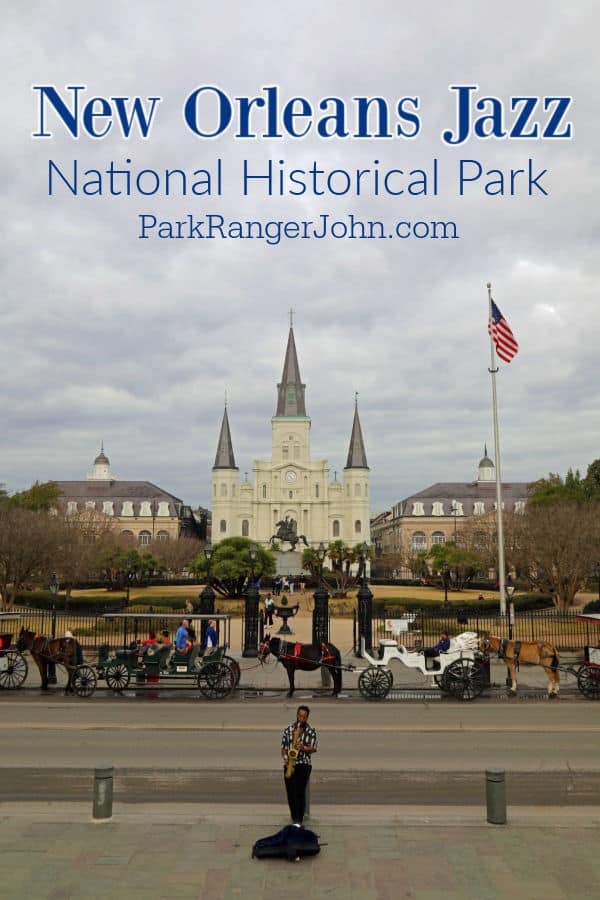
New Orleans Jazz National Historical Park
New Orleans Jazz National Historical Park is a park, unlike many other parks. You have to go into a visit to New Orleans Jazz NHP with an open mind and willingness to visit many different places.
About New Orleans Jazz National Historical Park
The visitor center is truly the information center for the park but from there you are on your own journey to experience and enjoy New Orleans Jazz.
Make sure and plan time in your visit to check out a local jazz show or hear live music.
You can learn about the history of Jazz at the visitor centers but you truly can't soak it all in without hearing at least a little bit of live music.
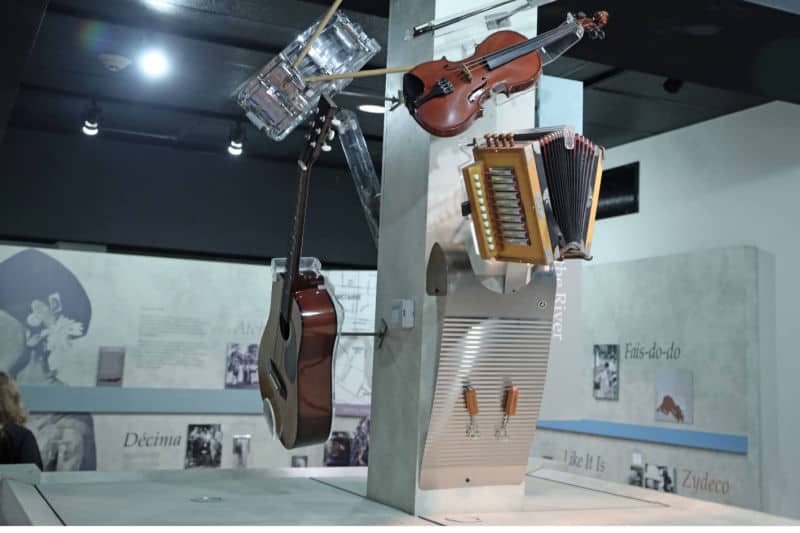
Is New Orleans Jazz National Historical Park worth visiting?
Yes! This US National Historical Park does a great job sharing the importance of Jazz music to New Orleans.
This park is a bit different from many other parks so you want to be prepared that a lot of it is about places other than the visitor center.
History of New Orleans Jazz National Historical Park
New Orleans Jazz National Historical Park is located in the Treme neighborhood of New Orleans, near the French Quarter.
The park was designated in 1994 to preserve information, resources, and sites associated with the history of jazz in New Orleans.
The land between the southern mouth of the Mississippi River and Lake Pontchartrain was a rich opportunity for settlement long before the Europeans were attracted to the area.
Indigenous people knew the value of inhabiting an area with considerable ecological resources and numerous points of access to rivers and bays.
After being claimed by French explorer Robert Cavelier, Sieur de La Salle in 1682, New Orleans was founded by Jean Baptiste Le Moyne de Bienville in 1718.
The streets laid out and created at that time became what is known today as the French Quarter.
France later ceded the land to Spain and in 1803 the land became part of the United States after the Louisiana Purchase.
Although the city was no longer owned by France, the French language, religion, and customs stayed prevalent. At this time, also prevalent were the Creoles – a large population of native-born citizens who were descendants of French immigrants.
Their sophisticated culture stood out from any other American city at the time. In the 19th century, New Orleans became a famous spot for immigrants because of its location as a major seaport.
Immigrants from numerous nations arrived and blended with the French and Creoles as well as African natives brought from the West Indies.
The unique blend of these groups, along with a very strong influence from African tribal instruments, chants, and rituals brought about the origin of jazz in New Orleans.
Long before jazz was born, New Orleans had a passion for music. It was the first city in North America that had an opera house.
Musical events were consistently part of every social gathering in the city from dances to funerals.
One large aspect that separated New Orleans from the rest of the south was the fact that they allowed the African culture to thrive.
Slaves were allowed to congregate in Congo Square and share a fellowship of music and dancing. This area is on the edge of the French Quarter inside the Historical Park.
Additionally, during the 19th century, New Orleans was home to the largest population of free people of color.
These groups made up a large part of the musical groups in the city. It was during these performances that the style of spontaneous music was born.
Instead of playing a specifically rehearsed music number, performers put on a show of a more improvisational nature and used emotion to drive their music.
Built-in 1820, Perseverance Hall was originally a Masonic lodge, the first in Louisiana. Located within the National Historical Park, this site was largely used as a dance hall for Louisiana Creole jazz performances to entertain black and white citizens alike.
It has long been asserted that a man named Buddy Bolden was the first jazz musician.
Born in New Orleans in 1877, Bolden was a cornet player who began a musical group and gained much fame during the years between 1900 and 1907.
Mixing a variety of sounds from gospel music, to ragtime to blues to the unique improvisational style, “King” Buddy greatly influenced the younger musicians to come in New Orleans.
Sadly, in 1907, at the age of just 30, Bolden’s musical life abruptly ended when he was admitted to the Louisiana State Insane Asylum. Bolden was diagnosed with dementia praecox, which today we call schizophrenia.
It is believed that there is a strong chance Bolden was suffering from pellagra, a deficiency of niacin that was prevalent in the black population in the south at that time. Bolden died at the asylum in Jackson, Louisiana at the age of 54.
The majority of New Orleans Jazz National Historical Park consists of four acres inside Louis Armstrong Park. Additionally, there is a visitor center and concert venue a few blocks from the French Quarter. Louis Armstrong has been called the most influential jazz player of all time.
Born in 1900 in New Orleans, Louis Armstrong grew up in extreme poverty during the time period when jazz was just getting started.
In 1913, after firing a gun in the air, Armstrong was sent to the Colored Waifs Home in New Orleans as a juvenile delinquent, which may have been the best thing that could’ve happened to him.
It was here that Armstrong received music lessons and music became his ultimate passion. He learned the cornet and grew his skill to rival the leading cornet player in New Orleans, King Oliver.
In 1922, Oliver asked Armstrong to play the second cornet in his band in Chicago. Armstrong also began playing the trumpet for other big-name bands.
Jazz was beginning to be known throughout the country and Armstrong was soon encouraged by his new wife, Lil Hardin, to begin his solo career.
Armstrong moved from Chicago to New York City and soon toured the country. His legacy was that of trumpeter, soloist, singer, and eventually film star.
Armstrong is credited with taking the newfound art of jazz in New Orleans at the start of the 1900s and turning it into a style of music that is still loved today.
A beautiful example of a melting pot of people, styles, and cultures, the New Orleans Jazz National Historical Park celebrates the origin of jazz in America.
The people and places that created a musical style are still very much alive in the city a century later.
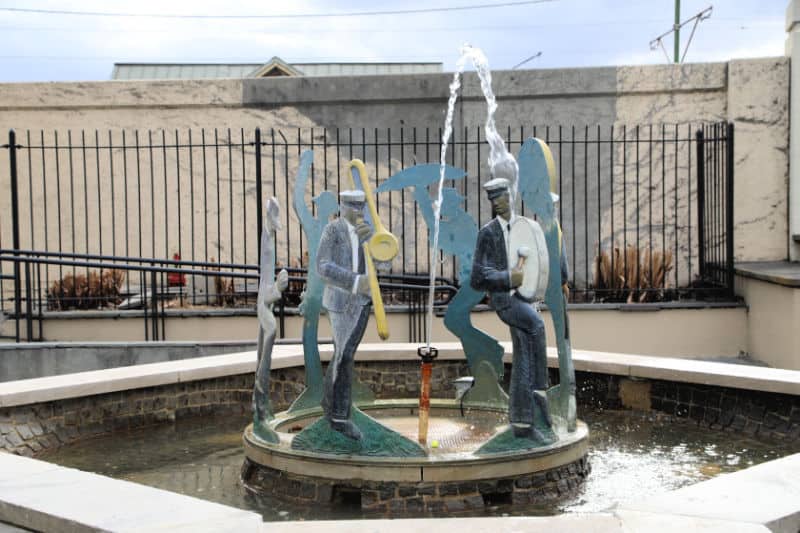
Things to know before your visit to New Orleans Jazz National Historical Park
Entrance fee
$0.00 - There is no entrance fee to visit the park.
Learn more about National Park Passes for parks that have an entrance fee.
$80.00 - For the America the Beautiful/National Park Pass. The pass covers entrance fees to all US National Park Sites and over 2,000 Federal Recreation Fee Sites for an entire year and covers everyone in the car for per-vehicle sites and up to 4 adults for per-person sites.

Buy your pass at this link, and REI will donate 10% of pass proceeds to the National Forest Foundation, National Park Foundation, and the U.S. Endowment for Forestry & Communities.
National Park Free Entrance Days -Mark your calendars with the five free entrance days the National Park Service offers annually.
Time Zone
Central Time Zone
Pets
Pets are not allowed in buildings of the park.
Cell Service
We had great cell service while visiting the park.
Park Hours
Open Tuesday-Saturday, 9:00 am - 4:30 pm.
Wi-Fi
There is no cell service within the park but you should have great cell phone service
Insect Repellent
Insect repellent is always a great idea when outdoors, especially if you are around any body of water.
We use Permethrin Spray on our clothes before our park trips.
Water Bottle
Make sure to bring your own water bottle and plenty of water with you. Plastic water bottles are not sold in the park.
Parking
There are paid parking lots spread through New Orleans.
Food/Restaurants
There are no specific restaurants dedicated to the park but there are a ton of French Quarter Restaurants and other great restaurants nearby.
Gas
There are no gas stations within the park.
Drones
Drones are not permitted within National Park Sites.
National Park Passport Stamps
National Park Passport stamps can be found in the visitor center.
New Orleans Jazz NHP is part of the 2019 Passport Stamp Set.
We like to use these circle stickers for park stamps so we don't have to bring our passport book with us on every trip.
The National Park Passport Book program is a great way to document all of the parks you have visitied.
You can get Passport Stickers and Annual Stamp Sets to help enhance your Passport Book.
Electric Vehicle Charging
There are over 40 public EV Charging ports within New Orleans
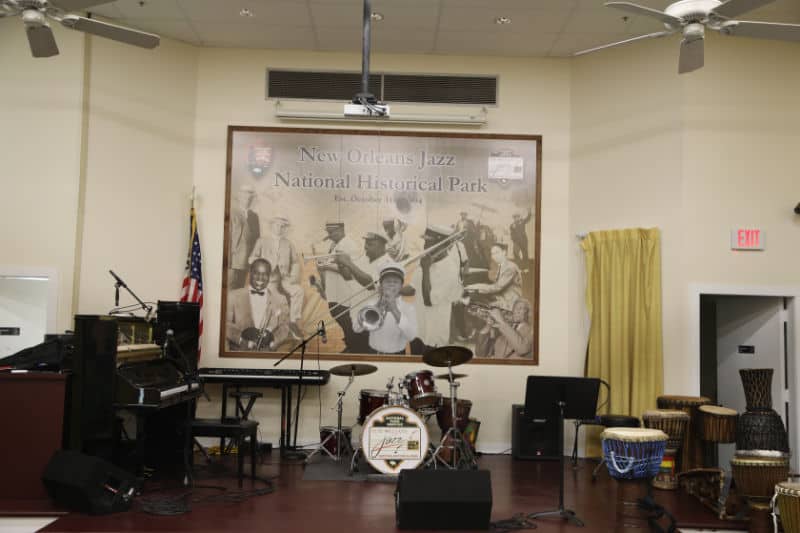
Details about New Orleans Jazz National Historical Park
Size - 4 acres
Check out how the park compares to other National Parks by Size.
Date Established
October 31, 1994
Visitation
In 2021, New Orleans Jazz NHP had 25,750 park visitors.
In 2020, New Orleans Jazz NHP had 9,460 park visitors.
In 2019, New Orleans Jazz NHP had 41,049 park visitors.
Learn more about the most visited and least visited National Parks in the US
National Park Address
419 Decatur St
New Orleans, LA 70130
National Park Map
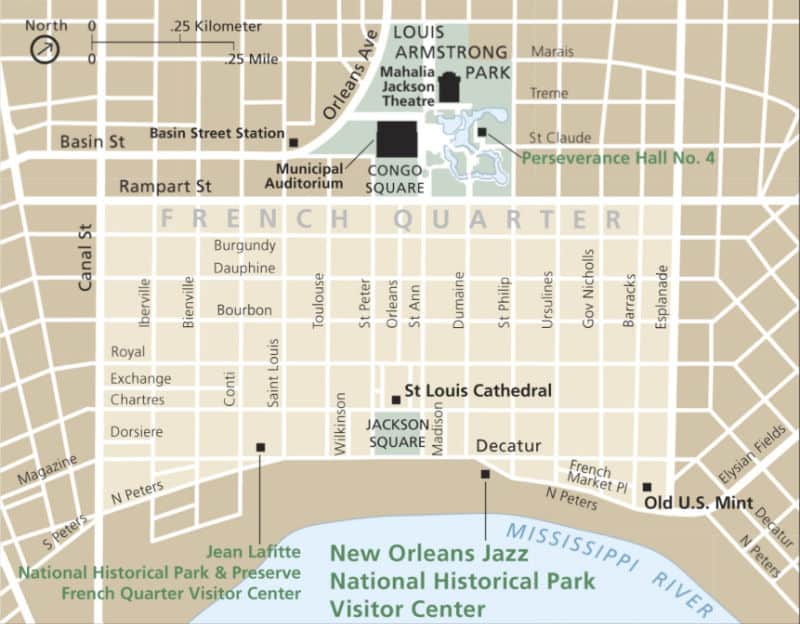
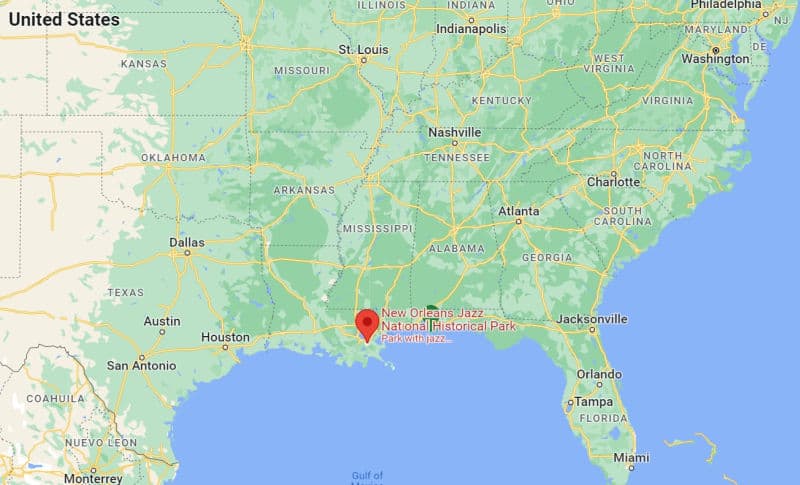
Where is New Orleans Jazz National Historical Park?
New Orleans Jazz NHP is located in the French Quarter of New Orleans, Louisiana.
Estimated distance from major cities nearby
- Baton Rouge, LA - 82 miles
- Birmingham, AL - 342 miles
- Houston, TX - 349 miles
- Memphis, TN - 398 miles
- Atlanta, GA - 468 miles
- Dallas, TX - 494 miles
- Plano, TX - 504 miles
- Austin, TX - 512 miles
Estimated Distance from nearby National Park
Great Smoky Mountains National Park - 594 miles
Mammoth Cave National Park - 624 miles
Big Bend National Park - 948 miles
New River Gorge National Park - 877 miles
Gateway Arch National Park - 680 miles
Where is the National Park Visitor Center?
New Orleans Jazz National Historical Park operations moved to the Jean Lafitte National Historical Park & Preserve French Quarter visitor center, 419 Decatur St., New Orleans, LA 70130.
Getting to New Orleans Jazz National Historical Park
Closest Airports
Louis Armstrong New Orleans International Airport (MSY)
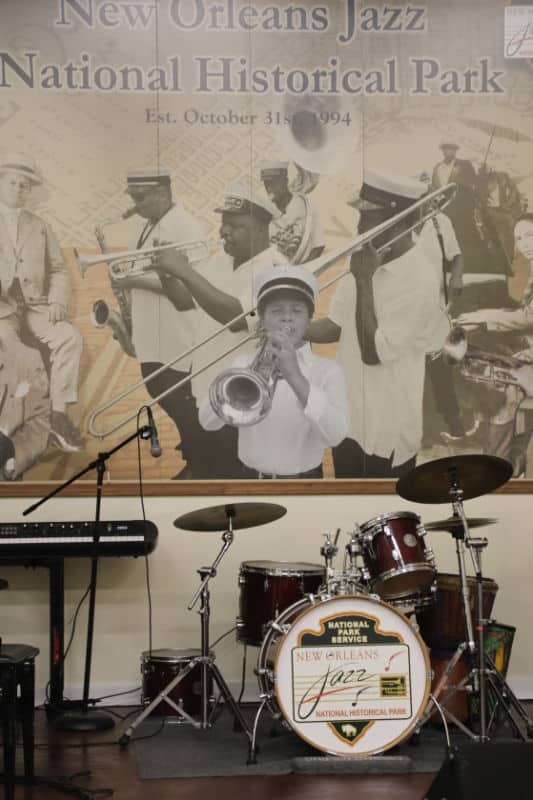
Best time to visit New Orleans Jazz National Historical Park
The best time to visit New Orleans is spring and fall when the muggy weather is a little more manageable.
Weather and Seasons
New Orleans, Louisiana experiences long hot muggy summers and cold but short winters.
The hottest weather in New Orleans is from May 19th to September 22nd when the average daily temperature is above 87 degrees.
The coldest weather is from November 29th to February 24th when the average daily temperature is below 69 degrees.
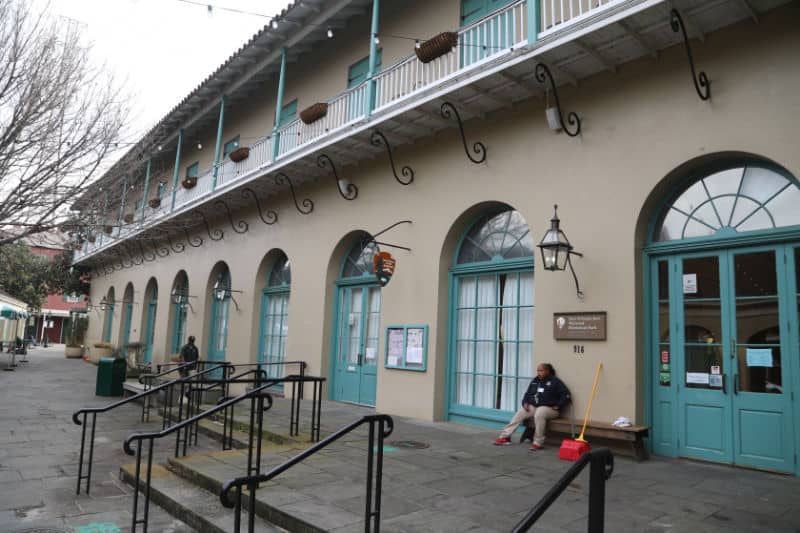
Best Things to do in New Orleans Jazz National Historical Park
Visitor Center
The visitor center is truly the informational heart of the park.
This is the place to visit to find out what events are happening in New Orleans while you are there, check out a ranger program, pick up your Junior Ranger program and experience some of the instruments used in New Orleans Jazz.
Junior Ranger Program
The Junior Ranger program is pretty easy to complete with a visit to the visitor center. There is a maze, object find, word search, and matching famous musicians to their instruments.
The Junior Ranger program has a great list of kid-friendly places to hear live jazz music in New Orleans.
Ranger-Led Programs/Live Music Demonstrations
One of the really cool things about the New Orleans Jazz NHP is most of the rangers are musicians. You can attend a ranger program that includes live music and a discussion of the music.
Self-Guided Walking Tour
Pick up a map at the visitor center and head out to explore more of New Orleans.
There are 11 stops on the walking tour that gives you more information about the heart of New Orleans Jazz.
Audio clips are available for each stop by calling 504-613-4062 at the prompt enter the desired stop proceeded by a "0". Example - stop 1 would be #01
Hiking in New Orleans Jazz National Historical Park
Always carry the 10 essentials for outdoor survival when exploring.
There are no real hiking trails in the park but you do want to be prepared for lots of walking.
Make sure to wear comfortable shoes, bring water with you, and be prepared for heat and humidity.
How to beat the crowds in New Orleans Jazz NHP?
The best way to beat the crowd is to visit during the off-season.
Where to stay when visiting New Orleans Jazz NHP
There are no National Park Lodges within the park.
The Ritz-Carlton, New Orleans - Bourbon Street and Caesars Superdome are located near The Ritz-Carlton, New Orleans, which provides a grocery/convenience store, a terrace, and a coffee shop/café. Treat yourself to a hot stone massage, a manicure/pedicure, or a body treatment at The Ritz-Carlton Spa, the onsite spa. The onsite restaurant, M Bistro, features brunch. Free Wi-Fi in public areas is available to all guests, along with a garden and a library.
AC Hotel by Marriott New Orleans French Quarter - Near Caesars Superdome and Bourbon Street, AC Hotel by Marriott New Orleans French Quarter provides a rooftop terrace, dry cleaning/laundry services, and a bar. Be sure to enjoy a meal at AC Kitchen, the onsite café. Stay connected with free in-room Wi-Fi, and guests can find other amenities such as a 24-hour gym and a 24-hour business center.
There are a ton of lodging and vacation rentals available in New Orleans. Click on the map below for additional options.
Camping
There are no National Park Campgrounds within the park.

For a fun adventure check out Escape Campervans. These campervans have built in beds, kitchen area with refrigerators, and more. You can have them fully set up with kitchen supplies, bedding, and other fun extras. They are painted with epic designs you can't miss!
Escape Campervans has offices in Vancouver, Seattle, Portland, San Francisco, Las Vegas, Los Angeles, Phoenix, Salt Lake City, Denver, New York, and Orlando
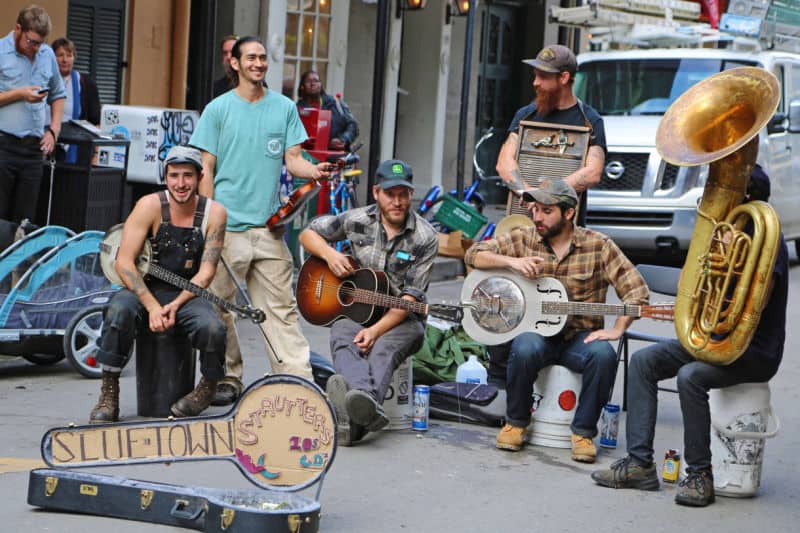
Parks Near New Orleans Jazz National Historical Park
Jean Lafitte National Historical Park and Preserve
Gulf Islands National Seashore
Natchez National Historical Park
Vicksburg National Military Park
Poverty Point National Monument
Check out all of the Louisiana National Parks along with National Parks in Texas, Mississippi National Parks, and Arkansas National Parks
Don't miss all of these fun things to do with kids in New Orleans! There are so many fun activities and things to try in the city!
Make sure to follow Park Ranger John on Facebook, Instagram, Pinterest, and TikTok





Leave a Reply